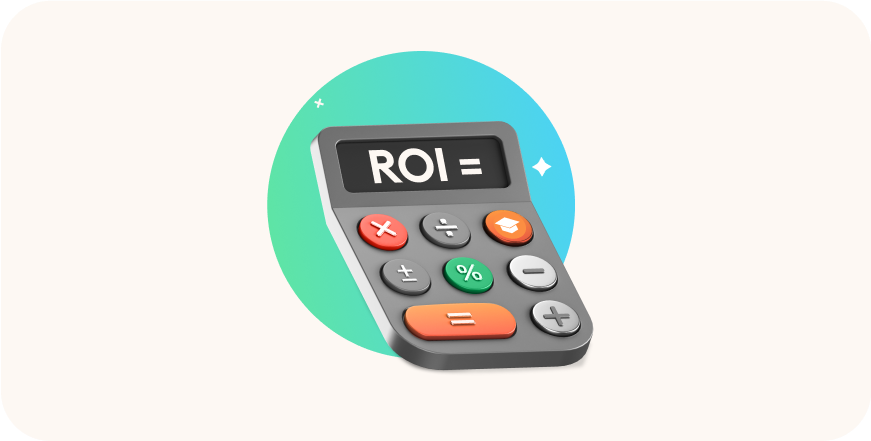eLearning ROI and How to Measure It: Kirkpatrick’s Model

Investing in employee learning and development has become a good tone for companies; in 2024, in the US only, total training expenditures amounted to $98 billion, slightly less than the historical high of 2023 ($101.8 billion). It’s only fair that in return, company leaders want to know what value eLearning development initiatives bring in terms of numbers.
In this blog post, we’ll introduce you to the eLearning ROI methodology, share one of the most efficient ROI calculation and measurement models, and provide a detailed plan on how to measure eLearning ROI with the help of learning management systems and show its training value to stakeholders. But first, take our short quiz to find out if your company is ready to get started with an ROI evaluation.
What Is eLearning ROI and Why Should We Care?
Return on investment, or ROI, is the ultimate measure of business performance that shows the ratio of what you invest to what you get in return. The metric is familiar to that of any accountant or financial expert and has credibility among executives. This is why it is the perfect measure to appraise the success of an organization’s strategy.
For eLearning, the idea of calculating ROI is to convert both training costs and benefits into a single value, e.g., dollars. This is great because the measure provides a clear assessment of the effectiveness of training based on the financial outcome of that training.
The general formula for calculating eLearning ROI looks like this:

The general ROI formula
A positive ROI means the training has paid off, and a negative ROI indicates losses. Let’s look at the example:
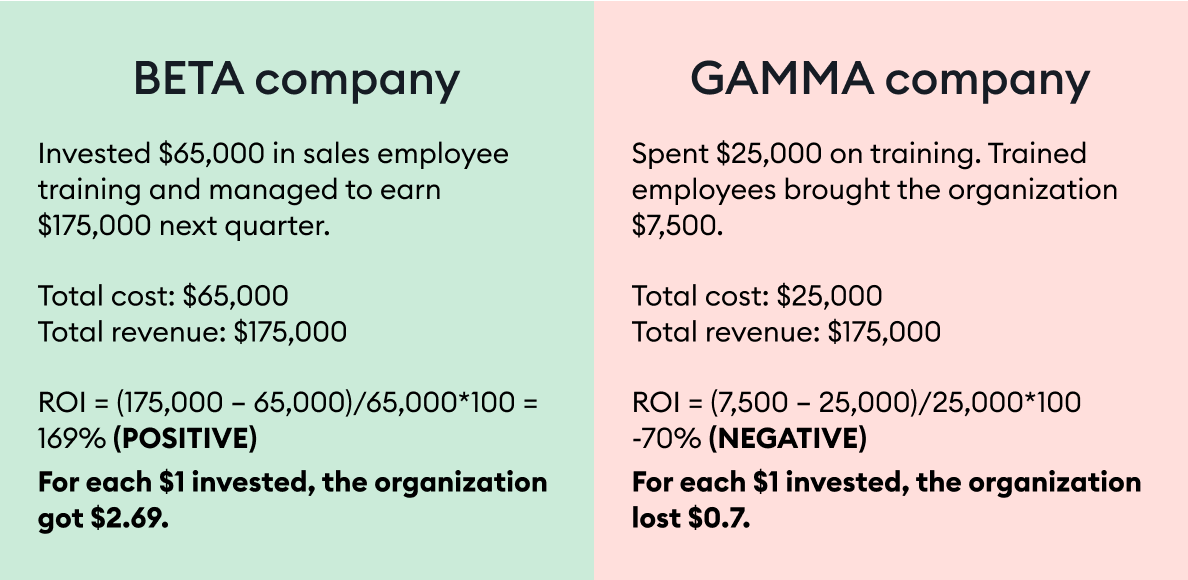
Looks easy: the negative ROI is bad, and the positive ROI is good. But subject matter experts know there is a challenge. Imagine that your ROI keeps staying positive, but the numbers are always low: let’s say a group of analysts told you that the ROI of your last course was 7%. At this point, many questions may arise:
- Is this ROI enough? Spoiler: the sky’s the limit in terms of ROI numbers, but every organization has to hit the minimum ROI, which means that the strategy works and is worth the enhancements.
- What prevented you from doing better?
- How can you increase the numbers?
- How do you know that the result was obtained from training and not from new technology or marketing?
Answering these questions can be a challenge, especially if the course is not directly related to sales or something that has a direct monetary value. Without additional data gathered, the eLearning ROI metric doesn’t tell the whole story. To interpret the results correctly, you’ll have to use an established methodology that includes other performance metrics as well. Let’s look at the methodology Donald Kirkpatrick offered back in 1959 to assess the performance of a huge enterprise with all its complexity.
What Is Kirkpatrick’s Model of Training Evaluation?
The most renowned model for measuring training effectiveness is Donald Kirkpatrick’s model, which features four levels. Kirkpatrick suggested that besides eLearning ROI numbers, businesses must also assess the following factors:
- Reaction: If the learners liked the training.
- Learning: The list of actual skills learners gained.
- Behavior: The use of the new skills in actual working tasks.
- Results: The general impact the training had on the organization.
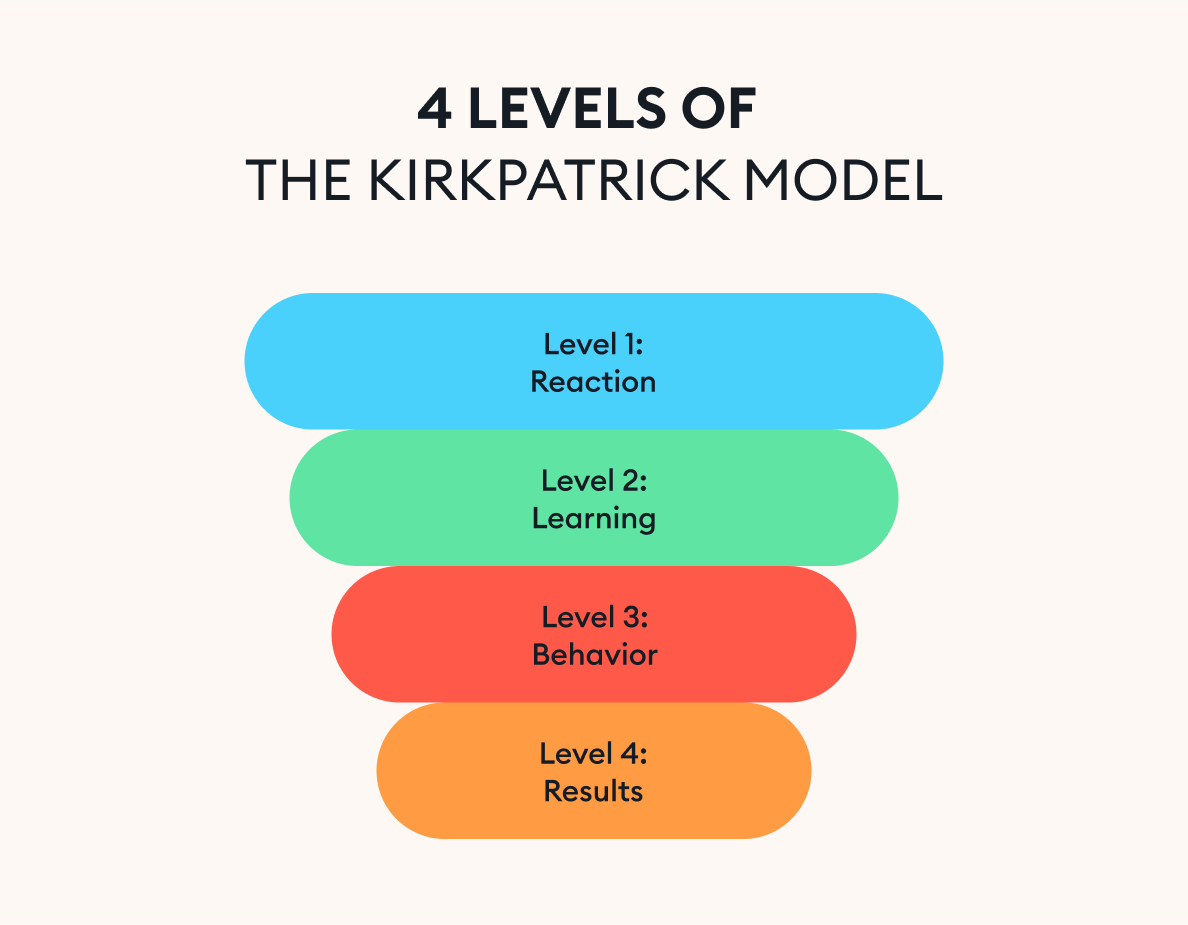
The four levels of Kirkpatrick’s Model
Though the model was offered back in the 1950s, it still tops the list of all evaluation models currently available. Moreover, most of the existing models are based on the four key levels of Kirkpatrick’s original model.
Calculating eLearning ROI Using Kirkpatrick’s Evaluation Model
So, how do you measure eLearning ROI based on Kirkpatrick’s model? You’ll need to assess four factors besides counting numbers (the exact ROI formula we mentioned in the beginning). Let’s dive into each one deeper to discover what to look at and how to assess the result.
Level 1 – Reaction
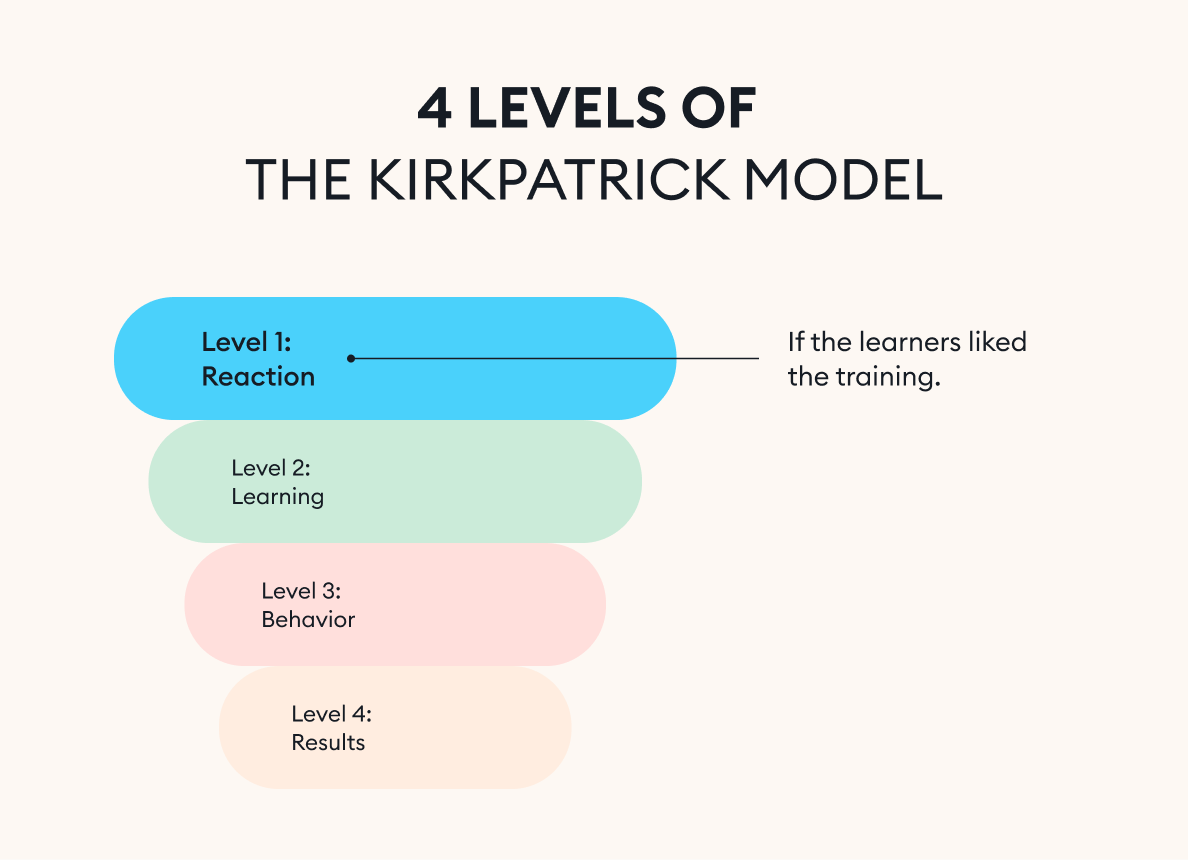
Reaction level of the Kirkpatrick pyramid
This easiest and most frequently assessed level builds a foundation for your eLearning ROI assessment. No hidden cameras are needed to track learners’ reactions: they are usually gathered by collecting feedback via quizzes and feedback forms or by collecting the particular reactions for using your LMS. The key result you can get at this point is the level of satisfaction your learners have. If the training is relevant and engaging, employees will show it in feedback forms.
But what’s the potential problem at this level? When assessing the level of employee satisfaction, keep your initial goals in mind. To find a balance between the learners’ happiness and actual use of the program, include the trainer’s point of view in the analysis. For example, not only must trainees express their opinion on how easy and fun it was to learn new things, but the trainer must also express their opinion on the following:
- Ease in using the LMS;
- The level of complexity of the material;
- The simplicity of sharing information;
- If the timing was enough to cover all materials;
- If the existing course of learning and development helped to achieve the training goals.
TIP: Always create at least two kinds of polls and quizzes at the end of a training program: one for learners and another for trainers. This will help you gather more comprehensive data on the course.
The data collected at this level will show you if the course was learner-friendly, but then you’ll need to move on to assessing the course’s efficiency.
Level 2 – Learning
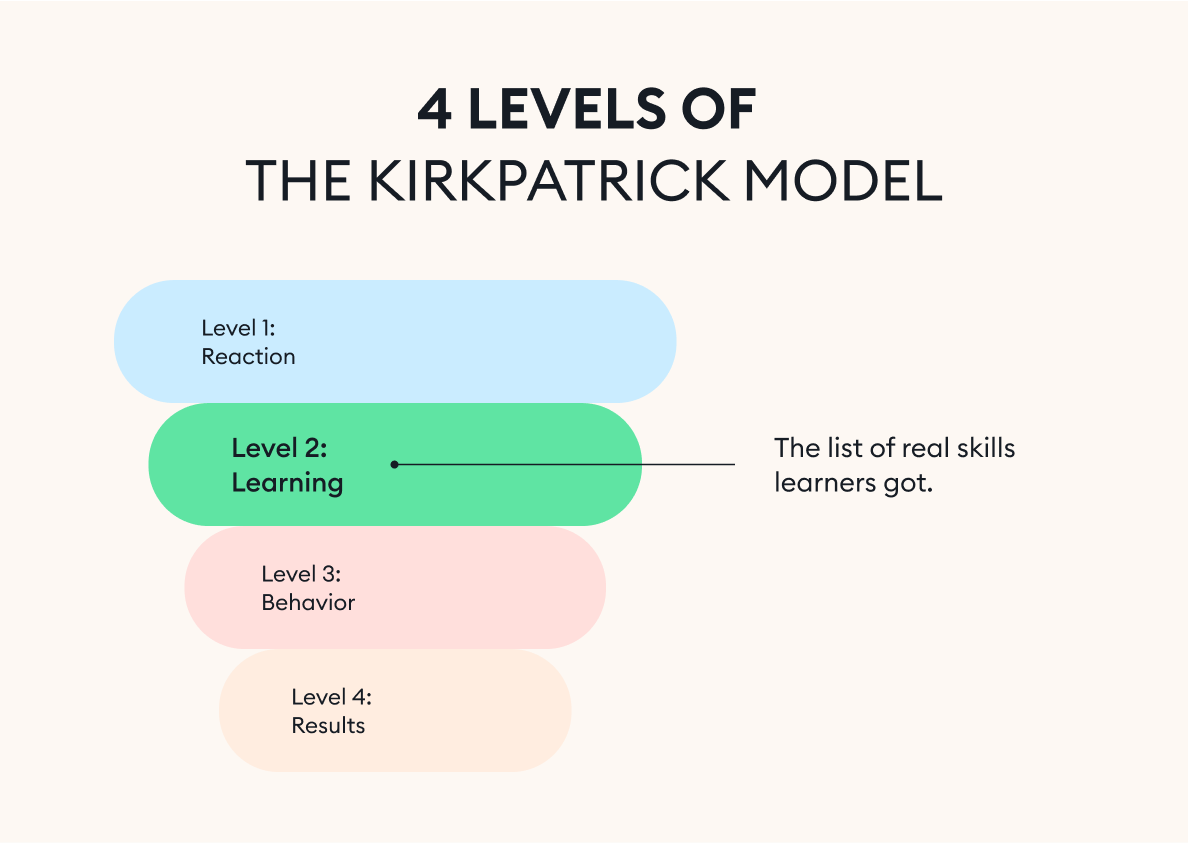
Learning level of the Kirkpatrick pyramid
The second evaluation step includes assessing how the level of learners’ knowledge and skills changed after the training. Ideally, you’ll need to collect their level of knowledge before the training starts so you have reference numbers. Comparing pre-learning and post-learning assessments and exams will show if the eLearning program was useful. This is a formal approach.
For an informal learning data assessment, conduct an interview or observe learners using their new skills in a real-case scenario. Ask your learners to describe what they would do in a certain case related to the training or offer some role-play activities where employees can demonstrate the skills they acquired.
TIP: Offering your employees a scoring test in your LMS is a standard formal practice that shows the level of learners’ knowledge and also allows for providing them with certificates. Regardless of what area your training is tailored for, look for ways to use informal assessments; such activities can help to develop fresh knowledge further by practicing them while providing you with more realistic data on learners’ knowledge than simple testing.
Assessing your employees’ skills in a modeled situation is always good, but that’s not all: you’ll see the actual progress only when an employee uses them in real life, with unexpected factors and additional challenges.
Table #1: An example of post-testing employees after completion of the training.
| Strongly disagree | Absolutely agree | ||||
| 1. The course topic was relevant to me. | 1 | 2 | 3 | 4 | 5 |
| 2. The instructor has a good understanding of the subject and can provide learners with a comprehensible explanation. | 1 | 2 | 3 | 4 | 5 |
| 3. I’ll be able to use information from the course in my daily work. | 1 | 2 | 3 | 4 | 5 |
Level 3 – Behavior
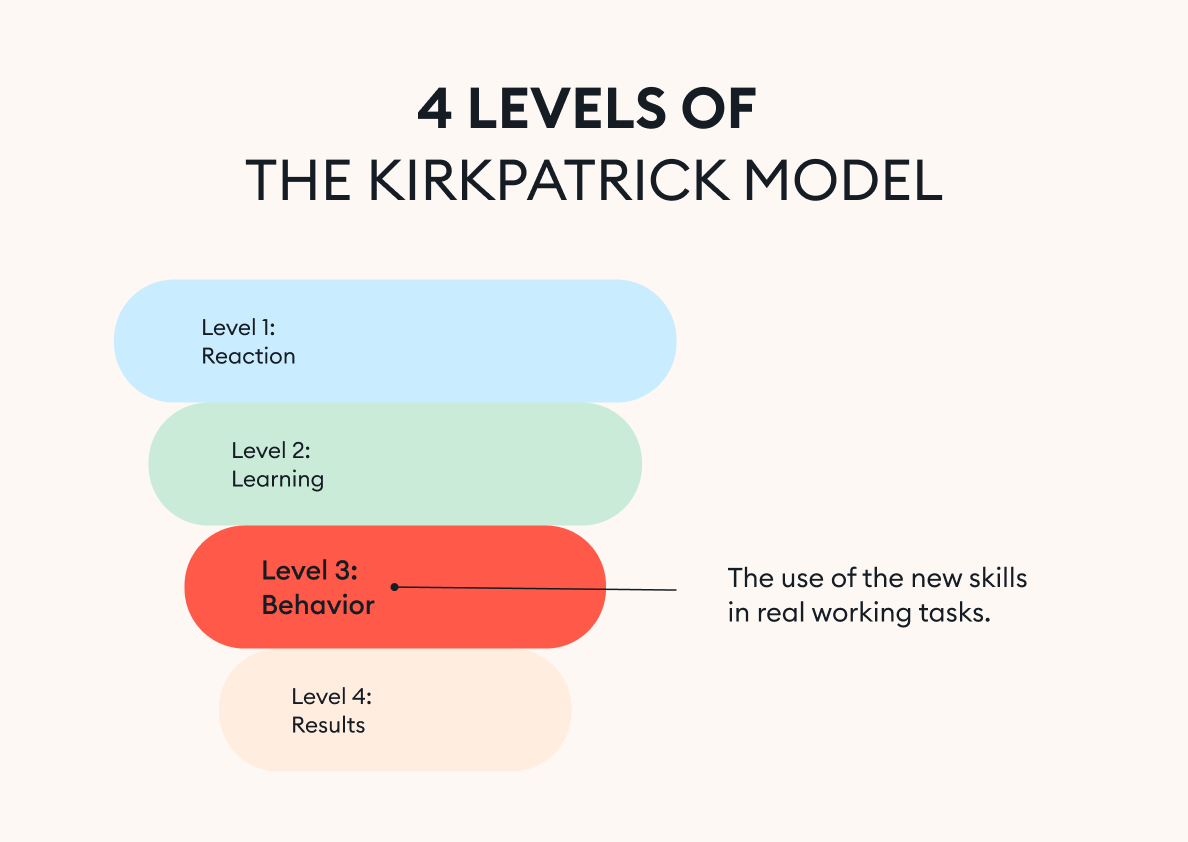
Behavior level of the Kirkpatrick pyramid
This level is about real training results, wherein you’ll need to assess whether the knowledge and skills acquired during the learning process are actually used in the workplace, away from the learning management systems. This level of assessment will demonstrate both the level of knowledge from the previous point and if the skills offered in the training were chosen correctly.
The approach may include both formal and informal methods of evaluation. Among formal methods, you can use performance review data and KPIs. However, if your organization doesn’t use any performance review metrics that could be expressed in numbers, you can always use regular observation on particular employees, 1:1 meetings, and feedback from their line manager and colleagues.
TIP: To encourage your employees to demonstrate what they learned, ensure that your organization builds a proper environment that grants them a chance to express themselves. If the current environment is insufficient, assign them new projects and opportunities to apply the new skills.
The most challenging thing about behavior assessment is making sure your employees’ behavior changed thanks to the training and was not caused by other factors. Use employee managers to compare their behavior before and after training. Remember that total isolation, like creating pilot groups, might provide a completely inaccurate result because the actual work is always impacted by something, and total isolation means returning to a learning level and creating a perfect environment that can never be recreated in real life.
Level 4 – Impact or Results
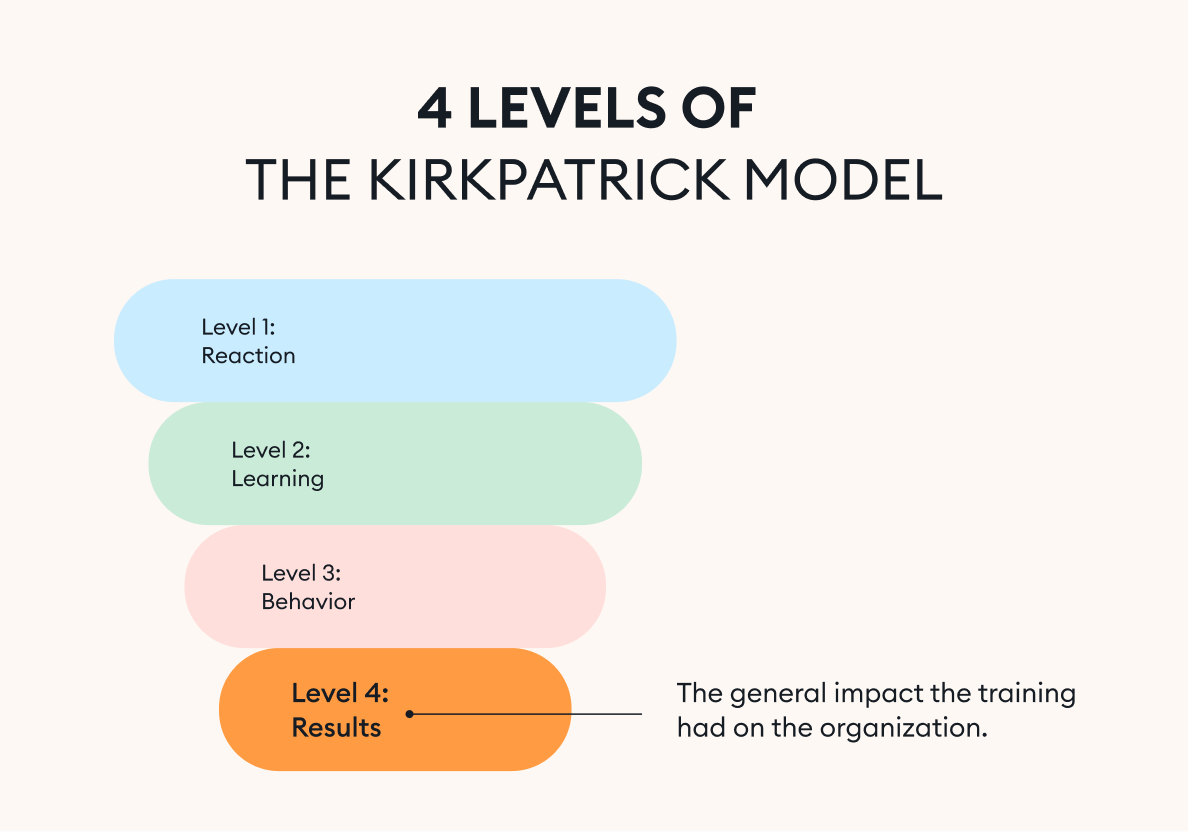
Results level of the Kirkpatrick pyramid
This level provides the most valuable data to assess. Here, you can assess how the training contributed to general business results. This means you’re going to use sales data, financial reports, LMS reports, eLearning ROI, and other measurements in numbers, the level of customer satisfaction, and more.
Financial metrics play the biggest role in the Level 4 analysis. However, besides such audits, you also have to pay attention to how internal processes change, if the training affects the general effectiveness of employees, and even if the retention rate and customer satisfaction numbers have changed.
TIP: The main challenge here is collecting clear data by isolating training results from other factors and business impact. The best way to do this is to plan the training for the most stable part of the year if your organization is affected by seasonal changes and avoid combining your training with other massive changes, like employee rearrangement or cultural changes. At the same time, try establishing a baseline before the training starts and compare results to these numbers as the training ends and at least a quarter passes.
A systematic approach to eLearning ROI metrics, constant internal process review, and case study recording can help you make Level 4 assessments easier and also provide a lasting impact on the training.
General assessment of eLearning ROI
Along with a standard ROI in numbers, the four factors offered by Donald Kirkpatrick show the most comprehensive picture of your training’s efficiency. So, when beginning your eLearning initiatives, consider using Kirkpatrick’s model to assess it and ensure that your organization is offering all needed opportunities for learning and development and can collect the initial data on employees’ efficiency to compare it with the results.
A Practical Way to Apply ROI to Your eLearning Program
Assess your previous training
When you launch a long-term, large-scale LMS-based program, such as a corporate university, it may take several years to achieve the maximum effect. If there are no desired results in the first year of training, there’s still a chance to change your training in accordance with the analysis and improve its results the following year. And the best way to find the shortcomings and improve them is to conduct a comprehensive eLearning ROI analysis using your LMS data on learners’ efficiency. The analysis can demonstrate if the learners were satisfied with certain points of the training and helps to find the weak points of the training quickly.
ROI is usually calculated annually. You can do this more often, but remember that assessing ROI over a shorter timeframe than a quarter will probably provide a false result or no significant changes at all. This is why it’s recommended to assess eLearning ROI 4 times per year at most and 1 time per year as a minimum.
Compare your data
Once you have the assessment of all your previous training projects, you need to account for a comprehensive ROI of the current one and then compare the data. The two ROIs that you’ll get will show the general year-to-year efficiency of your training.
Comparing data in an LMS or manually helps express the difference transparently for future reporting to different audiences, like stakeholders. This transparency can help them understand your eLearning results better and support further enhancement of the training process.
Convert results to monetary values
Another way to better understand why a training program is efficient is to convert your eLearning ROI metrics into financial values. This usually helps stakeholders understand how efficient a training program actually is. As a rule, hard data, such as performance, time, and quality, can be easily converted into numerical values:
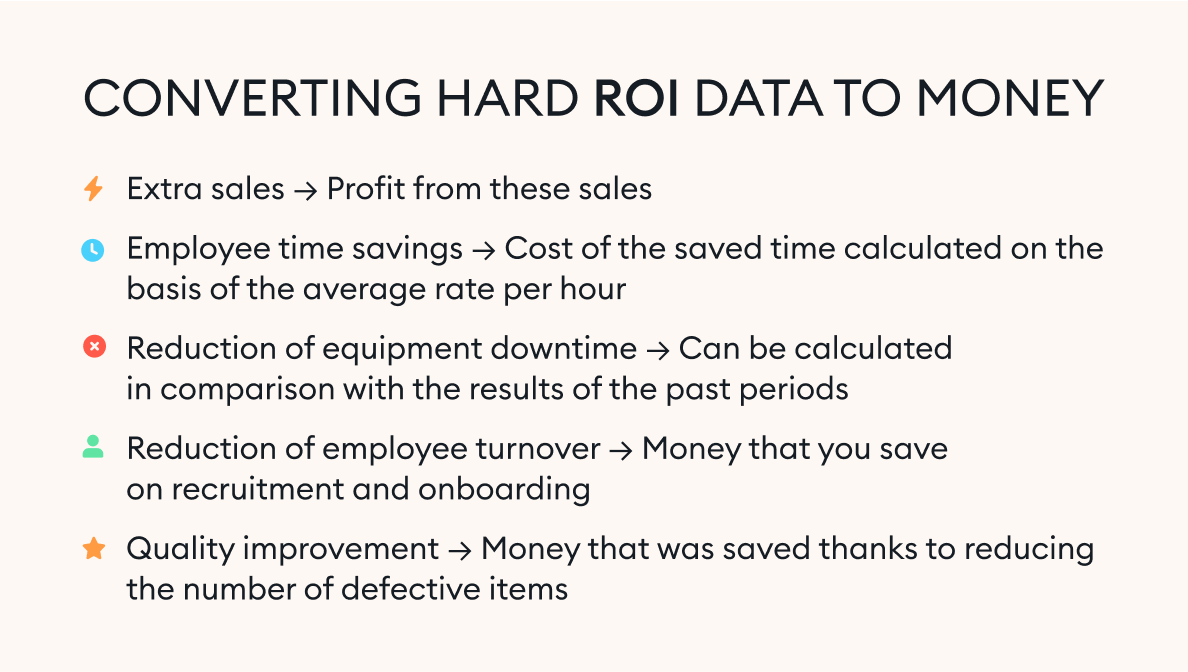
Converting hard ROI data to money
Sometimes, it can be challenging to transmit some of the values of your eLearning initiatives into monetary values. For example, proactive employees do help businesses to grow, but their efforts can’t be evaluated in numbers accurately. In this case, we suggest using the following plan on each value that you want to show in your reports but cannot readily convert into financial numbers.
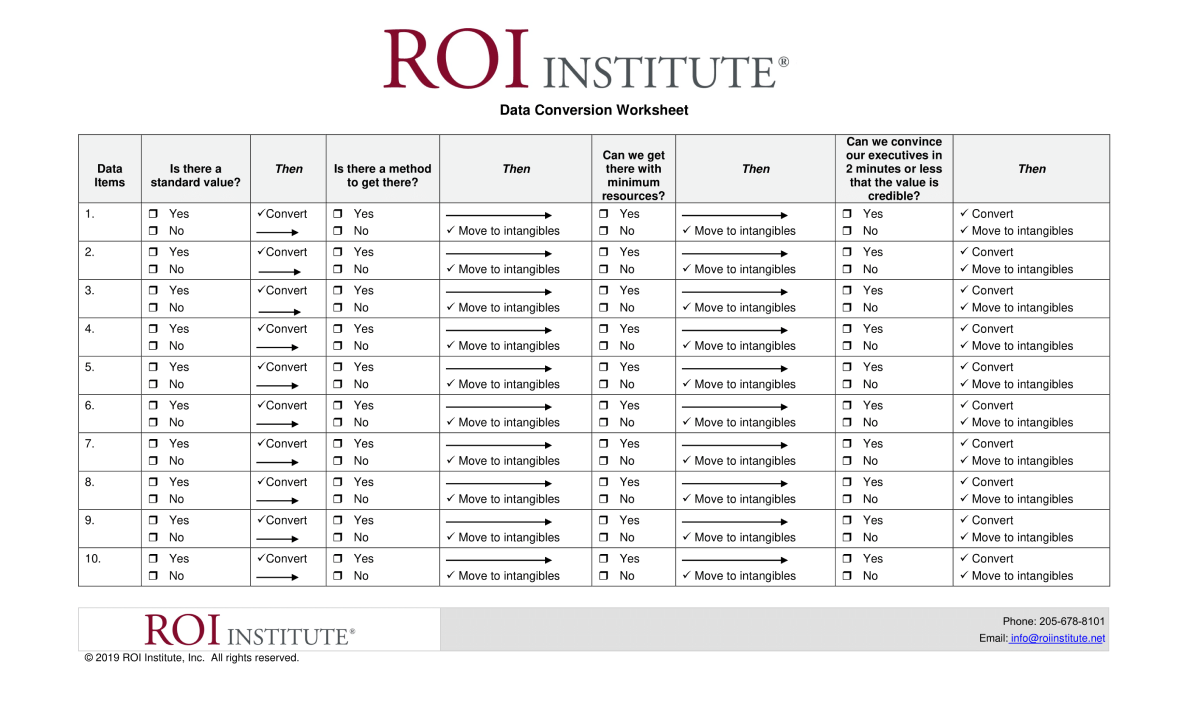
To convert or not to convert. Source: ROI Institute
Create training reports
At this point, when everything is evaluated and the only thing left is to demonstrate your training results to the world, you have two major tasks:
- Prepare reports for different audiences (stakeholders as the main one).
- Communicate results to all of these audiences.
To complete this step, you need a customizable LMS like iSpring LMS that offers robust reporting features. A good LMS must be able to provide detailed reports that can be converted into either live or online communication easily:
| Audience | Report | Communication channel |
| Stakeholders, executives |
| Live:
Online:
|
| Management |
| Live:
Online:
|
| PR and Marketing |
| Live:
Online:
|
| Employees |
| Live:
Online:
|
What Else Skyrockets Your eLearning ROI?
The ROI analysis shows the payoff of training programs by converting training costs and benefits into money. With Kirkpatrick’s Model in mind, you can see that your ROI is great when you have the following factors in the pocket:
- High level of learners’ appreciation of the training (Reaction);
- Many high grades on exams (Learning);
- Active use of the new skills in practice (Behavior);
- General positive changes in your business success (Results).
But is there anything else in online training that helps to enhance your eLearning ROI metrics? Over 40% of Fortune 500 companies use eLearning, so there must be some other benefits in online training. We found at least three additional advantages.
eLearning is more cost-effective compared to traditional learning
eLearning itself includes both direct and indirect expenses, like instructors’ salaries, the cost of an LMS, the cost of a PR campaign for the program, etc. However, online learning is much more affordable compared to a traditional one. The use case of Dow Chemical, which saved $34 million by switching to eLearning, proves that the general cost of eLearning adds to a positive ROI of your training by saving you money.
Moreover, using a flexible and customizable LMS can save you a few million dollars additionally in a long perspective thanks to collecting a big bank of materials and being able to reformat them in accordance with the future needs and demands of learners.
Faster training delivery
According to Devlin Peck (subject matter experts), online learning reduces the time needed to learn a subject by 40% to 60%. This means that eLearning itself can enhance onboarding and even increase the retention rate significantly, as proven by the Boston Consulting Group study (there was a 9-10% higher retention rate among eLearning students).
Such an effect results from the convenient materials arrangement that LMSs offer and their integration capabilities: the learner gets everything in one place, from a wide range of accessible materials to different convenient formats and an opportunity to study on the go.
Improved training results
Online LMSs use innovative approaches to any eLearning initiatives. Adaptive training allows for better performance analysis and personalized training for each employee. The level of engagement is significantly higher in eLearning thanks to an individual approach, gamification, breaking materials and blocks into pieces, etc. This means that learners get deeper knowledge and upskill faster.
A great example of success is Marriott International, which used its eLearning programs to fill 55% of its leadership positions by training its personnel.
The Bottom Line
eLearning keeps its TOP position in enhancing business ROI, and the key task for businesses today is to find ways to improve their training programs’ efficiency. Besides tracking eLearning trends and endeavoring to comply with eLearning standards, businesses must also keep in mind that the correct choice of a corporate eLearning solution significantly affects the capabilities for online course development, performance assessment, and even eLearning ROI calculation.
This last item is especially important if you want to get an expected (or even better) result from your eLearning programs. The bottom line is that learning how to measure eLearning ROI is not an impossible task but has many important layers. The good news is that this process can be automated — at least partially — by a good LMS.
Ready to start your eLearning ROI journey? Start by having a strong LMS on board. Sign up for a free demo of iSpring LMS to discover what data you can retrieve from the system to assess the efficiency of your learning and which opportunities are here for you to improve your business ROI quickly!



